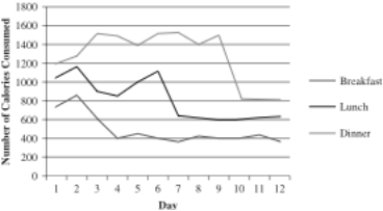Dr. Anderson is a nutritionist who helps clients lose weight prior to surgery. She is working with W. J., a male client who is planning on undergoing a heart transplant. He currently eats more than 3,500 calories a day and has been asked by his doctor to cut the number of calories to about 1,800 (400 for breakfast, 600 for lunch, and 800 for dinner) . She is curious as to whether a food journal will help W. J. reduce the number of calories he eats. A food journal is used to record everything a person eats to help patients be more aware of what they're eating. W. J.'s wife also recorded the food he consumed at each meal to have complete data before introducing the journal. Dr. Anderson decides to phase in the food journal gradually, initially only having W. J. record what he ate at breakfast during the first three days after baseline (days 4-6) . During days 7-9, the journal is used at lunch, too, and during days 10-12, it also is used during dinner. The data for Dr. Anderson's study are below.
What type of small-N design has Dr. Anderson used with W. J.?
A) Interrupted time-series design
B) Stable-baseline design
C) Multiple-baseline design
D) Reversal design
Correct Answer:
Verified
Q20: Dr. Fletcher is interested in whether joining
Q21: Seeing stability in a stable-baseline design can
Q22: Dr. Anderson is a nutritionist who helps
Q23: If a researcher is concerned about external
Q24: Dr. Anderson is a nutritionist who helps
Q26: Dr. Anderson is a nutritionist who helps
Q27: Dr. Anderson is a nutritionist who helps
Q28: Dr. LaGuardia is a cognitive neuroscientist who
Q29: Dr. LaGuardia is a cognitive neuroscientist who
Q30: Dr. Anderson is a nutritionist who helps
Unlock this Answer For Free Now!
View this answer and more for free by performing one of the following actions

Scan the QR code to install the App and get 2 free unlocks

Unlock quizzes for free by uploading documents